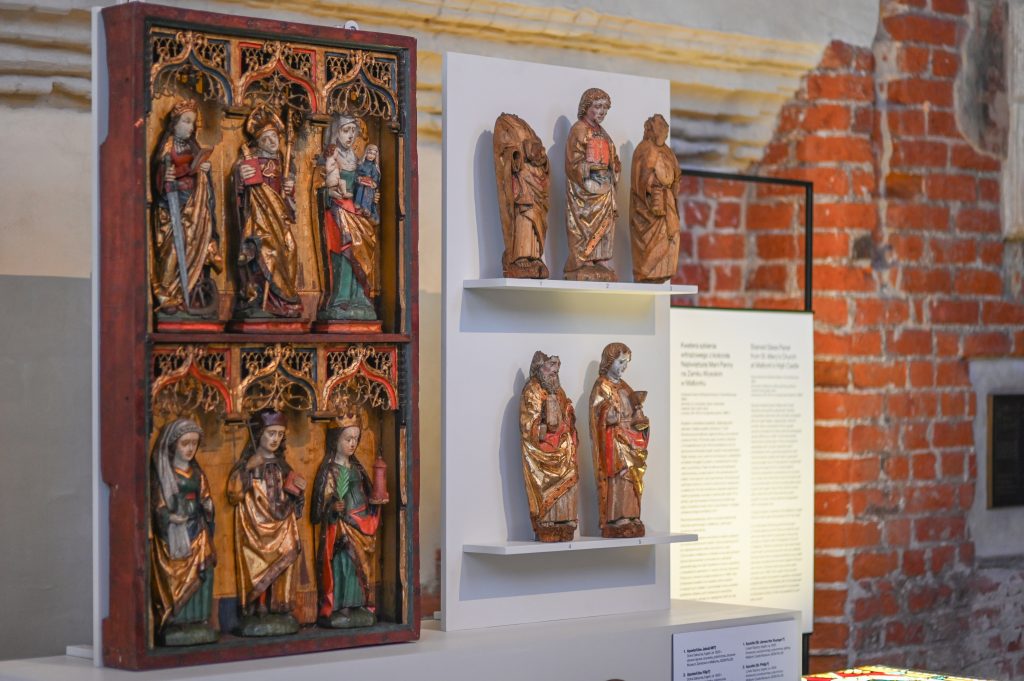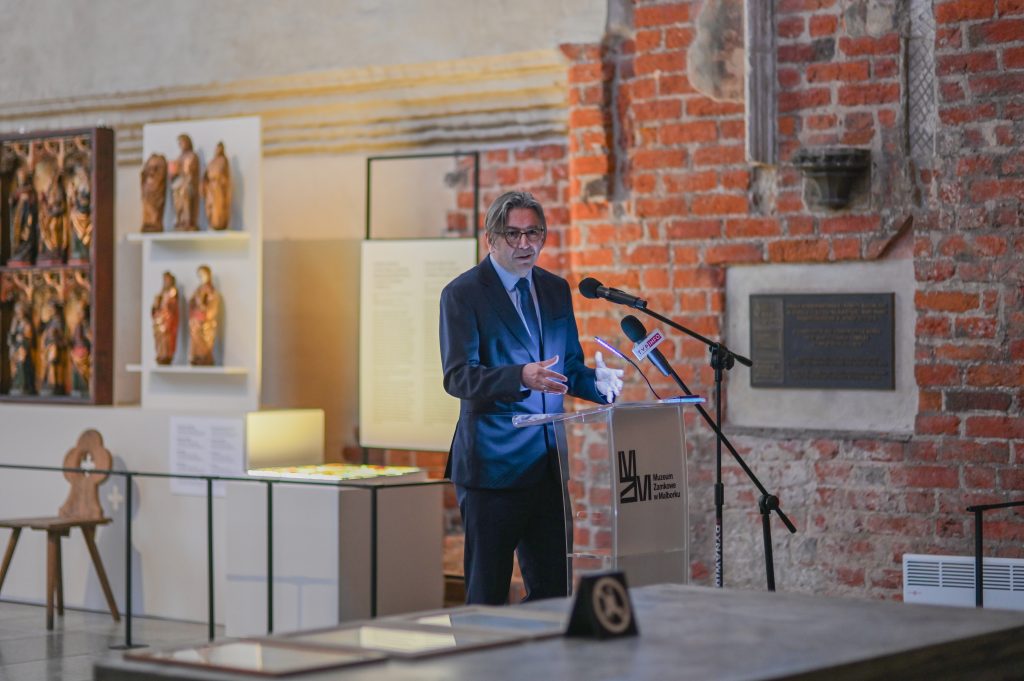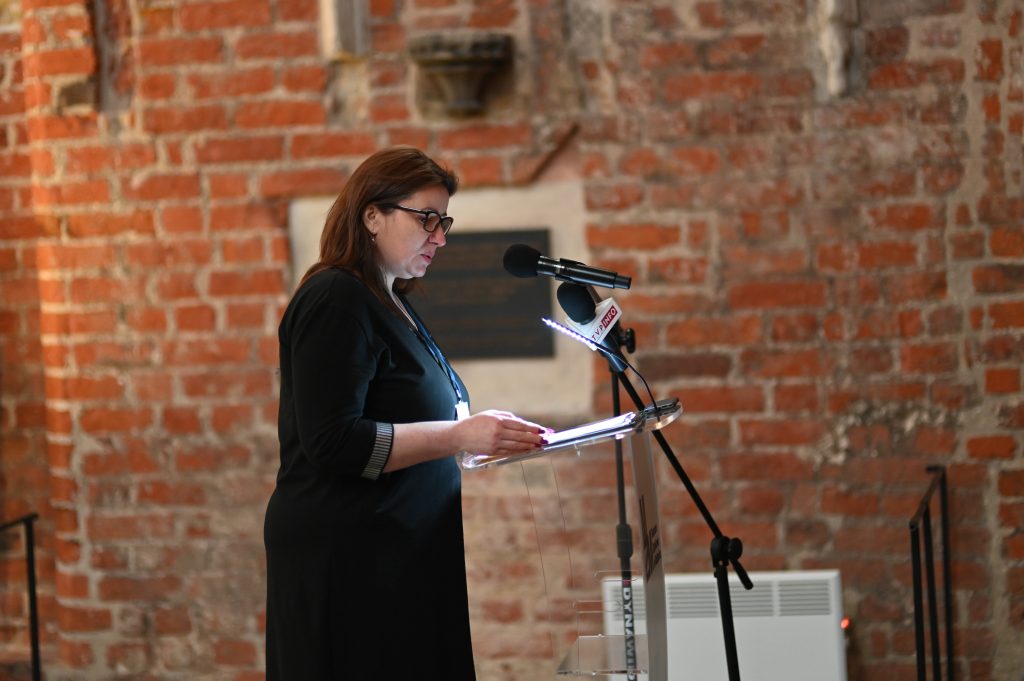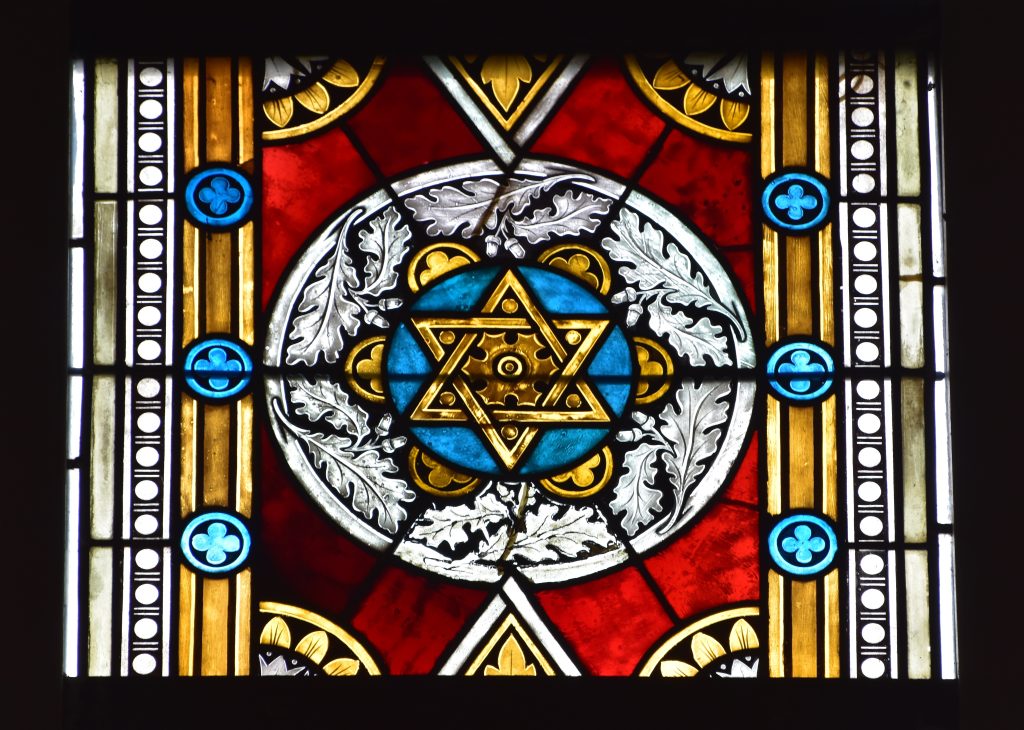News
More Artefacts Return to the Museum

Today’s meeting caps off years-long research on wartime losses and recent efforts to collect scattered works of art from Malbork Castle as part of the programme ‘Researching Polish Wartime Losses’, co-financed by the Ministry of Culture and National Heritage, as well as various other activities, which once again see items of Malbork provenance created before the war return to their place of origin. These items are:
– a stained-glass panel from Malbork High Castle’s St Mary’s church,
– an altar wing from Ingeln,
– an original Gothic Revival chair.
The donation ceremony was attended by many prominent guests, including Marta Cienkowska – Undersecretary of State at the MCaNH, Elżbieta Rogowska – Director of the Cultural Asset Restitution Department of the MCaNH, Agata Modzolewska – Head of the Cultural Asset Restitution Department of the MCaNH, Ewa Witkowska from the Cultural Asset Restitution Department of the MCaNH, Magdalena Tomaszewska – Department Head, MCaNH Information Centre, Father Tomasz Jank – Rector of the church of the Holy Trinity in Gdańsk, and Karolina and Wojciech Moraczewski.

‘I would like to thank all members of the museum staff who have worked on researching our wartime losses and restoring Malbork Castle to its former glory, but my most heartfelt and warmest thanks go to our donors, that is, to the Church, the Franciscan Order, for returning the altar wing; I would like to thank a private donor for the stained-glass panel, for their sense of civic responsibility and returning it to its original collection; and I would also like to thank Mr Zbigniew Szymański, who helped us find and identify the Gothic Revival chair that has now been returned to us. I am thankful to you for being here, and also that I can be here as well. This is our cultural heritage, and it is fortunate that it is now back where it belongs’, said Marta Cienkowska, Undersecretary of State at the Ministry of Culture and National Heritage.
Artefacts returning is the most satisfying part of the entire process, although it is important to keep in mind that it is always a result of arduous and long-term archival, museum and scientific research, which leads to the identification of items that were part of the Malbork Castle collection before the war. In the case of our castle, accurately evaluating our wartime losses is extremely difficult due to – with some exceptions – a lack of complete collection inventories or lists, as well as very scattered and scarce archival documentation.

‘Thanks to the work of our predecessors and ours, Malbork Castle is now part of our heritage. It is no longer foreign, problematic heritage, it is not a deposit given to us – the castle, with its entire history, which is complicated, difficult, but also rich, is our heritage’, said Dr Janusz Trupinda, Director of the Malbork Castle Museum.
In recent years, thanks to the support of the Ministry of Culture and National Heritage, we have conducted large-scale research as part of the Polish Wartime Losses programme, the results of which are now clear for everyone to see. Most importantly, the research has resulted in the identification of nearly 2000 items that were part of the Malbork Castle collection before the war and the publication of a two-volume catalogue of wartime losses, two source publications and two conference volumes, with more on the way. Since the project began, more than a dozen items have been returned to their place of origin, and several more are in the process of being returned in collaboration with the Restitution Department.

‘We are definitely lucky when it comes to people. It is thanks to the involvement of many different individuals that we are now able to celebrate the return of the ca. 1500 mediaeval altar wing and the 19th-century stained-glass panel. The top of the list obviously includes the donors themselves, who decided to donate the items to us upon learning about their provenance’, said Aleksandra Siuciak, Head of the Castle Research Library and project coordinator.
We would also like to thank Father Tomasz Janek, Rector of the church of the Holy Trinity in Gdańsk, and Mr Tadeusz Szostak from Warsaw, thanks to whom our collections will soon gain amazing new additions.
We are also extremely grateful to the Department of Cultural Asset Restitution of the Ministry of Culture and National Heritage for its continued support and full involvement in the restitution processes.
The items returning to the museum today, although created hundreds of years apart, are closely related to the place where the celebration took place, as both were purchased for the church of St Mary in Malbork’s High Castle.
A Few Words About the Donated Artefacts…

Stained-glass Panel from Malbork High Castle’s St Mary’s Church
Square panel. Lead-bound glass pieces. Panel consisting of 71 pieces. Central composition featuring a border on the left and right-hand side. The border’s vertical strips are divided into 4 square sections, each consisting of three vertical, rectangular strips of different width. The strips adjacent to the centre are separated with round pieces featuring a painted quarterfoil motif. The middle strips are stained dark and feature translucent (unstained) circles forming a bead pattern. The central composition consists of two concentric circles, with the inner featuring a hexagram cut from a single pane of glass. The lower and upper borders of the central part feature quarter-circle pieces placed in the corners, with triangles between them.
Original location: northern wall of the Malbork Castle church, first window on the western side.
We are certain that the panel was transferred as part of a set of stained-glass windows taken from the castle to the church as part of an agreement between the Malbork Culture Office and the Polish Army Museum. There are no archival documents confirming this, but mentions exist of similar church-related antique items (bells) being transferred from the castle to the church. The stained-glass windows were installed in 1953.

Ingeln Altar Wing
Rectangular altar wing divided horizontally into two sections, filled with sculptures arranged into rows of three. The upper borders of the sections are decorated with ogee and mandorla traceries. The wing features a crest consisting of flower-shaped pinnacles. The figures depict saints; upper row: the Virgin and Child with St Anne, St Lawrence and St Barbara; bottom row: St Mary Magdalene, St Catherine and a bishop. The background is gilded, and the frame is red. The remnants of the hinges indicate that this is the left wing. The wing is a remnant of a mediaeval altarpiece from a church in Ingeln, Lower Saxony. According to Bernhard Schmid, it was crafted in a Hildesheim-based workshop that reportedly also created the 1509 Altencelle altar. In the Early Modern Period, the Ingeln church was taken over by Protestants, and in 1700 the triptych was remade into a pulpit altar that was more suited to the needs of Evangelical liturgy.
The middle section now featured a pulpit, to which the wings were attached. As a result of this alteration, the six sculptures of saints from the predella and the middle section were now outside the altar. In 1893, both wings and some of the sculptures were purchased by Malbork Castle with the intention of decorating St Mary’s church, which was being renovated at the time. The left wing survived in the best condition, and, after being cleaned and repainted, was placed on the southern wall of the church, while the remaining twelve sculptures were used to fill two single-row altarpieces made to decorate the church’s side altars (St Mary’s and Christological).
In 1945, the wing was taken to the Gdańsk City Museum, from which it was transferred to the neighbouring Franciscan church at an unknown time and in unknown circumstances, where it remains to this day. The side altars with the Ingeln sculptures remained in the castle and were almost completely destroyed – only five sculptures, a chest fragment and a double-sided painted wing remain.
Tickets
Buy tickets online
Opening Hours
- Mon - Sun:9:00 - 20:00
Exhibitions
- Tue - Sun:9:00 - 19:00
Contact
Tourist Information
- +48 55 647 08 00
- +48 55 647 09 02
- +48 55 647 09 78